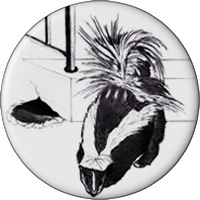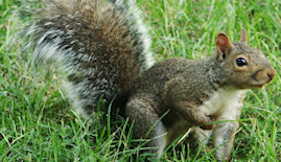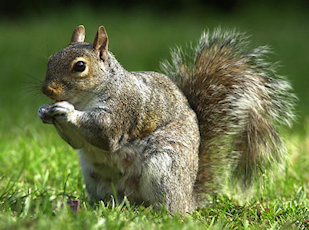SquirrelsIdentification
Food Habits Grey squirrels will eat a great variety of native foods and adapt quickly to unusual food sources. Typically, they feed on mast (wild tree fruits and nuts) in fall and early winter. Acorns, hickory nuts, walnuts, and fruits are favourite fall foods. Nuts are often cached for later use. In late winter and early spring they prefer tree buds. In summer they eat fruits, berries, and succulent plant materials. Fungi, corn, and cultivated fruits are taken when available. During population peaks, when food is scarce, these squirrels may chew bark from a variety of trees. They will also eat insects and other animal matter. General Biology, Reproduction, and Behaviour Gray squirrels breed when they are 1 year old. They breed in mid December or early January and again in June. Young squirrels may breed only once in their first year. The gestation period is 42 to 45 days. During the breeding season, noisy mating chases take place when one or more males pursue a female through the trees. They nest in tree cavities, manmade squirrel boxes, or in leaf nests. Leaf nests are constructed with a frame of sticks filled with dry leaves and lined with leaves, strips of bark, corn husks, or other materials. Survival of young in cavities is higher than in leaf nests. Cavities are the preferred nest sites. About 3 young comprise a litter. At birth they are hairless, blind, and their ears are closed. Newborns weigh about 14 g (1/2 ounce) at birth and 84 to 112 g (3 to 4 ounces) at 5 weeks. Young begin to explore outside the nest about the time they are weaned at 10 to 12 weeks. At weaning they are about half of their adult weight.
Squirrels are a food source for hawks, owls, snakes, and several mammalian predators. Predation seems to have little effect on squirrel populations. Typically about half the squirrels in a population die each year. In the wild, squirrels over 4 years old are rare, while in captivity individuals may live 10 years or more. The biology of other North American squirrels has much in common with that of fox and gray squirrels, although most other species have one breeding season per year. Damage Squirrels may occasionally damage forest trees by chewing bark from branches and trunks. Red squirrels damage Ponderosa pine, jack pine, and paper birch. This species and others may at cones and nip twigs to the extent that they interfere with natural reseeding of important forest trees. This is a particular problem in Ponderosa pine forests where pine squirrels may remove 60% to 80% of the cones in poor to fair seed years. In forest seed orchards, such squirrel damage interferes with commercial seed production. In nut orchards, squirrels can severely curtail production by eating nuts prematurely and by carrying off mature nuts. In fruit orchards, squirrels may eat ovaries of cherry blossoms and destroy ripe pears. Squirrels may chew bark of various orchard trees. In residential areas, squirrels sometimes travel power lines and short out transformers. They gnaw on wires, enter buildings, and build nests in attics. They frequently chew holes through pipelines used in maple syrup production. Squirrels occasionally damage lawns by burying or searching for and digging up nuts. They will chew bark and clip twigs on ornamental trees or shrubbery planted in yards. Often squirrels take food at feeders intended for birds. Sometimes they chew to enlarge openings of bird houses and then enter to eat nestling songbirds. In gardens, squirrels may eat planted seeds, mature fruits, or grains such as corn. |



 Eastern gray squirrels are variable in color. Some have distinct reddish cast to their gray coat. Black ones are common in some northern parts of their range. Eastern gray squirrels measure 41 to 51 cm (16 to 20 inches). They weigh from 567 g (1 1/4 pounds) to 794 g (1 3/4 pounds).
Eastern gray squirrels are variable in color. Some have distinct reddish cast to their gray coat. Black ones are common in some northern parts of their range. Eastern gray squirrels measure 41 to 51 cm (16 to 20 inches). They weigh from 567 g (1 1/4 pounds) to 794 g (1 3/4 pounds). Home range size depends on the season and availability of food. It may vary from 1 to 100 acres (0.4 to 40 ha). Squirrels move within their range according to availability of food. They often seek mast-bearing forests in fall and favour tender buds in elm and maple forests in the spring. During fall, squirrels may travel 80 km (50miles) or more in search of better habitat. Squirrel populations periodically rise and fall. During periods of high populations, squirrels, especially gray squirrels, may go on mass emigrations. At such times many animals die.
Home range size depends on the season and availability of food. It may vary from 1 to 100 acres (0.4 to 40 ha). Squirrels move within their range according to availability of food. They often seek mast-bearing forests in fall and favour tender buds in elm and maple forests in the spring. During fall, squirrels may travel 80 km (50miles) or more in search of better habitat. Squirrel populations periodically rise and fall. During periods of high populations, squirrels, especially gray squirrels, may go on mass emigrations. At such times many animals die.